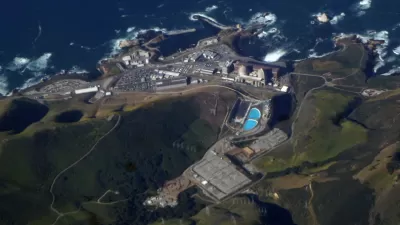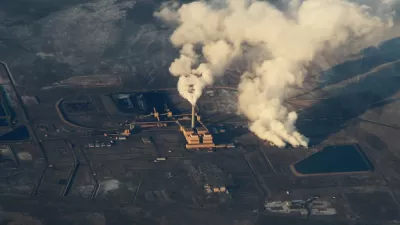Is California ready for an all-electric future? The California energy grid barely withstood its biggest test during last week's heat wave as residents cranked up their air conditioners. CalMatters columnist Dan Walters questions if the grid is ready.

“Last Tuesday, when power consumption peaked in the late afternoon, renewable sources, principally solar panels, supplied just over a quarter of [California Independent System Operator]-managed juice, while plants powered by natural gas were producing nearly half,” writes Dan Walters for CalMatters. “Later, as the sun began to set, solar arrays generated steadily less power, finally tapering off to zero, while the gas plants’ share of the load increased rapidly.”
Walters, who covered state politics for decades for The Sacramento Bee, is particularly focused on state energy legislation that would accelerate the transition to 100 percent clean electricity.
By happenstance, Tuesday’s test of the power grid’s resilience came just a few days after the Legislature passed – at Gov. Gavin Newsom’s behest – legislation to speed up California’s conversion to a carbon-free electrical grid by 2045. So the day’s experience provided a graphic snapshot of what must to happen for that conversion to occur.
The legislation, Senate Bill 1020 [additional description here], requires that California get 90% of its power from renewable sources by 2035 – the same year the state is now scheduled to end sales of gasoline-powered cars – and 95% by 2040 while retaining the 2045 deadline for converting to a carbon-free electrical grid [see SB 100].
Kathleen Ronayne, a Sacramento-based reporter for The Associated Press, also took note of the grid's reliance on natural gas during last Tuesday's record energy demand, calling it a ’fossil fuel conundrum’ in light of the state's green goals.
“We all want to accelerate the elimination of the gas, but it’s a sober reminder of reality,” Gov. Gavin Newsom told reporters on Wednesday (Sept. 7.).
Last Tuesday was indeed a reality test for the state's power grid operator. Requiring a faster transition to all-renewable power sources will undoubtedly make the current challenge more formidable.
“Is California really up the task that the new legislation mandates, a very expensive, relatively rapid conversion and expansion of this immensely complicated and absolutely vital thing we call the grid?” asks Walters in the third paragraph before the end of his column.
Recent history is not reassuring. This is a state government that took a quarter-century to replace one third of the San Francisco-Oakland Bay Bridge after the 1989 Loma Prieta earthquake, has been futzing around with a bullet train project for 14 years with little progress, and has dozens of bollixed information technology projects.
Electric power transformation would be infinitely more difficult than any of those.
Related posts on California's power grid
- Disaster Averted! Sept. 11, 2022
- The Beginning of the End of the Internal Combustion Engine Vehicle? August 29, 2022
- California May Join Hawaii With 100 Percent Renewable Energy by 2045, August 30, 2018
- California's Solar Power is Going to Waste, April 15, 2017
FULL STORY: Can California really make power grid 100% green?

Study: Maui’s Plan to Convert Vacation Rentals to Long-Term Housing Could Cause Nearly $1 Billion Economic Loss
The plan would reduce visitor accommodation by 25,% resulting in 1,900 jobs lost.

North Texas Transit Leaders Tout Benefits of TOD for Growing Region
At a summit focused on transit-oriented development, policymakers discussed how North Texas’ expanded light rail system can serve as a tool for economic growth.

Using Old Oil and Gas Wells for Green Energy Storage
Penn State researchers have found that repurposing abandoned oil and gas wells for geothermal-assisted compressed-air energy storage can boost efficiency, reduce environmental risks, and support clean energy and job transitions.

Planting Relief: Tackling Las Vegas Heat One Tree at a Time
Nevada Plants, a Las Vegas-based nonprofit, is combating the city’s extreme urban heat by giving away trees to residents in underserved neighborhoods, promoting shade, sustainability, and community health.

How Madison’s Tree Planting Efforts Are Growing a Healthier Community
Madison’s annual tree planting initiative is enhancing environmental resilience, public health, and community livability by adding 1,400 carefully selected trees citywide, with strong community and institutional support for urban forestry.

Texas State Bills Could Kill Transit Funding in Dallas, Austin
State lawmakers could pull funding from the state’s largest transit agency and the ambitious Project Connect, a voter-approved transit project in Austin.
Urban Design for Planners 1: Software Tools
This six-course series explores essential urban design concepts using open source software and equips planners with the tools they need to participate fully in the urban design process.
Planning for Universal Design
Learn the tools for implementing Universal Design in planning regulations.
Ascent Environmental
Borough of Carlisle
Institute for Housing and Urban Development Studies (IHS)
City of Grandview
Harvard GSD Executive Education
Toledo-Lucas County Plan Commissions
Salt Lake City
NYU Wagner Graduate School of Public Service





























